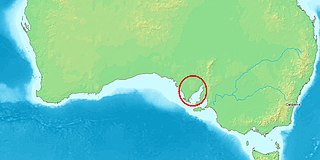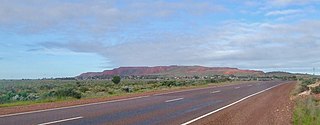Related Research Articles

Whyalla is a city in South Australia. It was founded as "Hummocks Hill", and was known by that name until 1916. It is the fourth most populous city in the Australian state of South Australia after Adelaide, Mount Gambier and Gawler and along with Port Pirie and Port Augusta is one of the three towns to make up the Iron Triangle. As of June 2018, Whyalla had an urban population of 21,742, having declined at an average annual rate of -0.75% year-over-year over the preceding five years. It is a seaport located on the east coast of the Eyre Peninsula and is known as the "Steel City" due to its integrated steelworks and shipbuilding heritage. The port of Whyalla has been exporting iron ore since 1903.

The Spencer Gulf is the westernmost and larger of two large inlets on the southern coast of Australia, in the state of South Australia, facing the Great Australian Bight. It spans from the Cape Catastrophe and Eyre Peninsula in the west to Cape Spencer and Yorke Peninsula in the east.

The Eyre Peninsula is a triangular peninsula in South Australia. It is bounded by the Spencer Gulf on the east, the Great Australian Bight on the west, and the Gawler Ranges to the north.

Iron Knob is a town in the Australian state of South Australia on the Eyre Peninsula immediately south of the Eyre Highway. At the 2006 census, Iron Knob and the surrounding area had a population of 199. The town obtained its name from its proximity to large deposits of iron ore, most notably Iron Monarch which outcropped prominently from the relatively flat, surrounding landscape.

The giant cuttlefish, also known as the Australian giant cuttlefish, is the world's largest cuttlefish species, growing to 50 cm (20 in) in mantle length and up to 100 cm (39 in) in total length. They can be over 10.5 kg (23 lb) in weight. Using cells known as chromatophores, the cuttlefish can put on spectacular displays, changing color in an instant. The giant cuttlefish is native to temperate and subtropical waters of Australia, from Brisbane in Queensland to Shark Bay in Western Australia and Tasmania to the south. It occurs on rocky reefs, seagrass beds, and sand and mud seafloor to a depth of 100 m (330 ft). In 2009 the species was listed at Near Threatened on the IUCN Red List of Threatened Species due to an observed declining trend at that time.
Arrium was an Australian mining and materials company, employing nearly 10,000 workers, that went into voluntary administration in 2016 with debts of more than $2 billion. In 2017 it was acquired by British-owned Liberty House Group.

The City of Whyalla is a local government area in South Australia, located at the north-east corner of the Eyre Peninsula. It was established in 1970, replacing the town commission, which had been running the town previously. The district is mostly industrial, with many large companies having factories in the city.

Port Bonython is the location of a deepwater port, gas fractionation plant and diesel storage facility west of Point Lowly in the Upper Spencer Gulf region of South Australia. It lies 16 km east-northeast of Whyalla, South Australia and approximately 370 km north-west of the State's capital city, Adelaide. The existing wharf is 2.4 kilometres long and is capable of berthing small Capesize ships with a maximum capacity of 110,000 tonnes. The wharf was established in 1982 and named after John Bonython, the founding chairman of Santos. The structure is leased to Santos by the Government of South Australia and is used for the export of hydrocarbon products. An oil spill at Port Bonython in 1992 resulted in loss of bird life and damage to mangrove habitats to the west and southwest of Port Pirie.

The Whyalla Steelworks is a fully integrated steelworks and the only manufacturer of rail in Australia. Iron ore is mined in the Middleback Range to feed the steelworks, resulting in the distribution of finished steel products of over 90 different grades. It occupies a 1,000 ha site on the shore of False Bay, Spencer Gulf and is the largest employer in Whyalla, South Australia.

The Olympic Dam mine is a large poly-metallic underground mine located in South Australia, 550 km (340 mi) NNW of Adelaide. It is the fourth largest copper deposit and the largest known single deposit of uranium in the world. Copper is the largest contributor to total revenue, accounting for approximately 70% of the mine's revenue, with the remaining 25% from uranium, and around 5% from silver and gold. BHP has owned and operated the mine since 2005. The mine was previously owned by Western Mining Corporation. Since the 1970s environmentalists, traditional owners and others have campaigned against the mine, largely on the basis of its contribution to the nuclear cycle and its use of underground water.

Point Lowly is the tip of a small peninsula north north-east of Whyalla in the Upper Spencer Gulf region of South Australia. The wider peninsula is shared by a combination of defence, industrial, residential, recreational and tourism interests. Port Bonython lies immediately to the north-west and is marked for future industrial expansion, driven by anticipated growth in the State's mining industry. The icons of the peninsula are the historic Point Lowly Lighthouse and the mass breeding aggregation of Australian giant cuttlefish which occurs inshore each winter.

The Point Lowly lighthouse was constructed in 1883 to guide ships safely through Spencer Gulf en route to Port Augusta and Port Pirie in South Australia. It was upgraded several times before being deactivated in 1993. It was reactivated in 1995 and is a tourist attraction for the Whyalla area and an icon of the Point Lowly area.
The False Bay is an 11-kilometre (6.8 mi) wide south-southeasterly facing bay in South Australia's upper Spencer Gulf region. It extends from the Whyalla steelworks at the southern end to Black Point at the eastern end. It features very wide, low gradient tidal, sand and salt flats which are up to 7 kilometres (4.3 mi) wide. Five very low energy, rarely visited beaches are accessible to the public. The two boundary beaches are accessible by vehicles from the Port Bonython Road while the central three are surrounded by salt and tidal flats and tidal creeks. False Bay's beaches are not patrolled but are rated among the state's least hazardous.

The South Australian Chamber of Mines and Energy (SACOME) is a not-for-profit, non-government organisation founded in 1979. It represents approximately 130 companies involved in resource extraction and supporting service industries in South Australia.
The Alternative Port Working Party is a community action group based in Whyalla, South Australia on the shore of northern Spencer Gulf. Its membership includes a number of retired engineers with experience in mining, shipping and bulk commodities handling and its chief spokesperson is Sid Wilson. Since its formation, the group has advocated for a 'best of both' scenario for the nearby Point Lowly peninsula; one which represents the interests of both the local economy and residential, recreational and tourist use of the peninsula. They believe that the chosen locations for proposed facilities in the Port Bonython and Point Lowly area present unacceptable compromises, and thus have recommended a number of alternatives.
Richard Yeeles in an English-born Australian businessman and former senior South Australian public servant with interests in the resources sector, particularly uranium mining and processing.
Stephen Charles Donnellan is the Chief Research Scientist of the Evolutionary Biology Unit at the South Australian Museum. He is also an Affiliate Professor at the University of Adelaide. Donnellan moved from New South Wales to South Australia in 1985 to undertake research recovering the evolutionary history of Australia's lizards. This work led to the establishment of a comprehensive collection of reptile and frog tissues from Australia and New Guinea. In 1990 Donnellan joined the South Australian Museum's staff and established the DNA laboratory there. His research since has focused on the evolution and biogeography of Australasian fauna. Donnellan has used molecular genetic methods to examine issues in the population genetics, phylogeography and phylogenetic relationships of vertebrates and selected invertebrate groups. Many of his research projects have been supported by the Australian Research Council (ARC). His work has been published in numerous scientific journals, including Biological Conservation, Evolution, International Journal for Parasitology, PLOS One, Restoration Ecology, Zoologica Scripta and Zootaxa.
Port Bonython Fuels is a fuel importation and diesel distribution hub at Port Bonython on the Point Lowly peninsula in South Australia's upper Spencer Gulf region. The development was designed to supply the State's expanding oil, gas and mineral resources sectors' operations in the north and west of the state. It allows South Australia to import fuel from ships carrying cargoes in excess of 100,000 tonnes- approximately four times the size of vessels currently importing diesel via Port Adelaide. The project is owned by Petro Diamond Australia, a wholly owned subsidiary of Mitsubishi Corporation. The first stage of the project was officially opened in May 2016.
The Braemar Alliance is a group of ASX-listed public and private mining and exploration companies with projects located in the Braemar region between Peterborough in South Australia and Broken Hill in neighboring New South Wales. The group was formed in 2011 with the intention of devising shared infrastructure solutions to provide water, power and freight corridors for the benefit of all members' projects. The Alliance's member companies have considered using existing outports and developing new ones on the eastern coast of Spencer Gulf to facilitate bulk exports, chiefly of iron ore. These include developing transshipping facilities at Port Pirie and building entirely new facilities at Myponie Point and south of Wallaroo. In July 2011, the Braemar Alliance had determined that its magnetite processing would require 50 gigalitres of water per year and that the water would be provided via a yet-to-be-constructed seawater desalination plant to be located on Spencer Gulf.
Fitzgerald Bay is a large bay located between Point Lowly and Backy Point in South Australia's upper Spencer Gulf. The bay's shoreline consists mostly of pebble beaches and sparse grey mangroves. In the 2000s the bay was used for the farming of yellowtail kingfish until their closure circa 2011 in response to high levels of fish mortality. Understanding of the environmental impacts of yellowtail kingfish farming is limited. As of 2021, fish farming has not returned to Fitzgerald Bay, but aquaculture zones remain in place, and Clean Seas is authorised to restock fish farms there. There are approximately forty shacks and coastal homes sparsely distributed along the fringe of Fitzgerald Bay whose interests are represented by the Cultana Jenkins Shackowners' Association.
References
- ↑ "whyallavet.com.au". Castleford veterinarian group. Retrieved 2014-12-19.
- 1 2 "Lauren Pearce starts petition to save Point Lowly". Save Point Lowly. Save Point Lowly. 2008-07-18. Archived from the original on October 24, 2009. Retrieved 2014-12-19.
- ↑ van der Haak, Melissa (2009-05-04). "Under fire". Southern Cross news. Retrieved 2014-12-19.
- ↑ Ooi, Esther (2011-05-23). "The Point Lowly desal plant that's got SA squabbling". Crikey. Retrieved 2014-12-19.
- ↑ McGregor, Ken (2011-05-18). "Save Point Lowly terms bulk ore port plan as 'third-rate'". The Advertiser. Retrieved 2014-12-24.
- ↑ Founten, Loukas (2009-09-18). "Media Monitoring - September 2009". Local Government Association of South Australia. Retrieved 2014-12-19.
- ↑ "Save Point Lowly". Save Point Lowly. Facebook. Retrieved 2014-12-19.
- ↑ "Save Point Lowly". Pandora - Australia's web archive. National Library of Australia. 2012-05-28. Retrieved 2014-12-19.